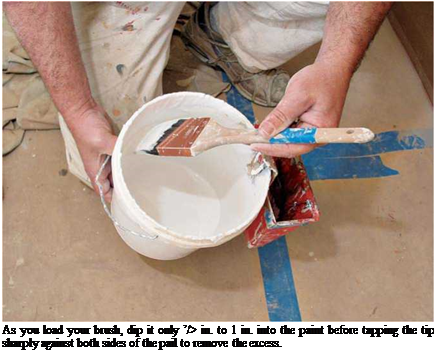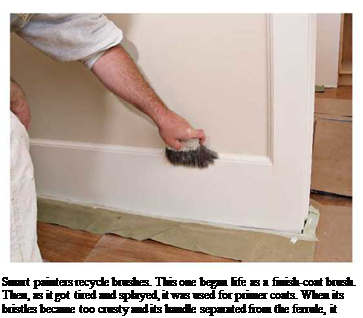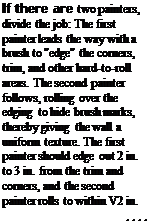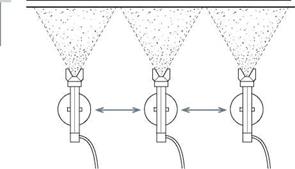BRUSH BASICS
The pros work steadily and methodically and note what works and what doesn’t. The following tips will help you keep the job moving and get great results.


![]()
Acclimate a new brush. Stand a new brush in 1 in. of oil-based paint for 5 minutes. After absorbing a bit of paint, the new bristles will release paint more readily when you start to work. Whereas thirsty new brushes may drag at first. It’s not necessary to acclimate brushes when using latex, which works into bristles within 20 seconds to 30 seconds.
Avoid overloading your brush. Most pros have only h in. to 1 in. of paint in the bottom of a paint pail when edging—and the same amount on the tip of the brush. With this small amount, you’ll cut a cleaner paint line and keep paint off the brush handle and your hands. And, should the bucket tip over, you’ll have less mess to clean up.
Retrieve loose bristles. If a bristle comes loose and sticks to the surface, pick it out by dabbing lightly with the tip of the brush. Quality brushes rarely lose bristles.
Paint with gravity. This is close to an absolute rule. Paint, as a liquid or mist, always falls or drips downward, so it’s better if it lands on unpainted surfaces—rather than painted ones. Best sequence: ceilings, walls, trim, baseboards.
Paint with the grain. When painting trim, brush paint in the direction of the wood grain. Painting cross-grain doesn’t help paint adhere better and will look terrible if brushstrokes dry quickly.
Steady hand, straight paint. Few pros use masking tape to achieve straight lines when brushing paint onto trim, window casing, and the like. Pros feel that tape takes too much time to apply and sometimes lets the paint seep under, leaving a ragged line. Besides, during removal, tape can pull off paint. Patience and a steady hand work better. With a little practice, it’s easier than you might think.
Acclimate roller covers to paint. Before using a new roller cover, work paint into it well. Load the cover with paint. Then roll it up and down the paint ramp to work the paint down to the base of its nap, and remove the excess.
Pros prefer ramps for paint rollers in 5-gal. buckets. Unlike roller pans, 5-gal. buckets don’t need frequent refilling, and there’s plenty of room to load the roller cover and roll off the excess.
The expanded metal ramp’s open grid also allows excess paint to fall directly into the reservoir of paint, rather than coating the side of the bucket.
Roll upward, after loading a roller with paint.
If you roll downward instead, you’ll be more likely spray excess paint onto walls and floors. Instead,
Roll paint in a zigzag. Roller covers contain the most paint during the first three to five passes, so first roll a Wor an Nto distribute "fat paint,” which you can then reroll to spread the paint evenly.
Lighten up with the roller once the paint is spread on the wall. This is especially important for outside corners (corners that project into a room). Too much pressure can make the roller skid or leave roller-edge marks.

![]()








Leave a reply